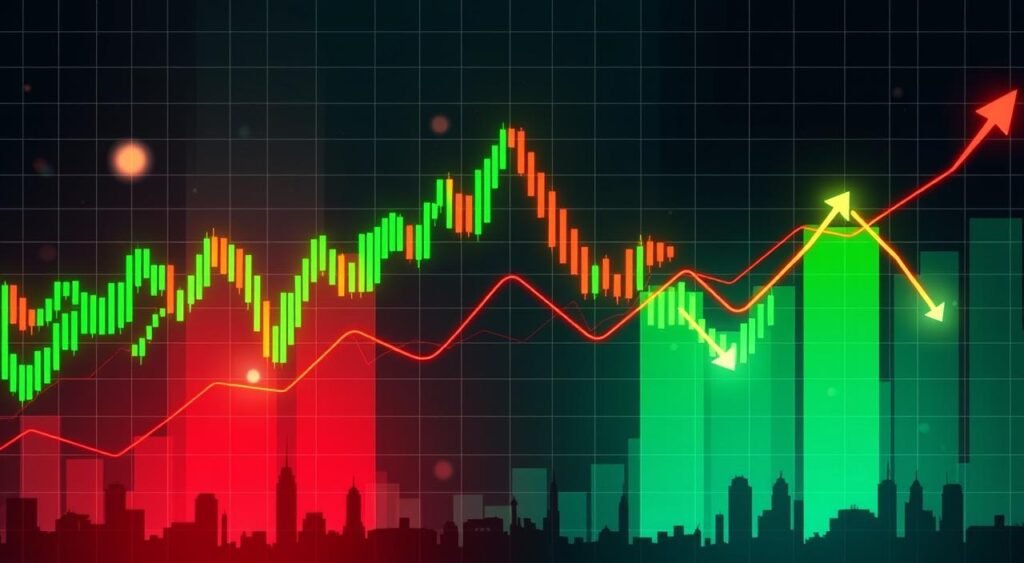About 70% of investors use stock market trends to guide their choices. The stock market futures market is huge and complex. It’s important to stay current with trends to make wise investment moves.
The stock market futures market shows the economy’s health. Knowing its trends helps investors make better choices for their money.
By tracking the latest trends, investors can understand the market’s direction. This knowledge is vital for both new and experienced investors. The market is always changing, so staying informed is crucial.
Key Takeaways
- Staying up-to-date with the latest stock market futures trends is crucial for investors to make smart investment decisions
- Understanding stock market trends can help investors make informed decisions about their portfolios
- The stock market futures market is a key indicator of the overall health of the economy
- Investors can gain valuable insights into the market’s direction by keeping a pulse on the latest stock market trends
- The stock market futures market is constantly evolving, and staying informed is key to making smart investment decisions
- Stock market futures trends can help investors navigate the complex world of futures trading
Understanding Today’s Stock Market Futures Landscape
To understand futures trading, knowing the current market is key. We look at economic signs, market mood, and world events. These help investors make smart choices and stay ahead.
Market indicators shape the future of the stock market. They include:
- Economic signs like GDP and inflation
- Market mood, shown in surveys and trends
- Global events, like political shifts and disasters
Global economic changes also impact the stock market. For example, changes in interest rates and trade policies can sway markets. Market analysis helps grasp these effects and guide investments.
By studying these elements and keeping up with trends, investors can excel in futures trading. This means doing deep market analysis and knowing about global economic shifts.
| Market Indicator | Description |
|---|---|
| Economic Indicators | GDP, inflation rates, unemployment rates |
| Market Sentiment | Investor surveys, market trends |
| Global Events | Political changes, natural disasters |
Stock Market Futures: Breaking Down Recent Performance
Many investors are keen on the recent trends in stock market futures. Stock market news is key in shaping their investment strategies. The market has seen ups and downs, influenced by economic indicators, global events, and market sentiment.
Let’s examine some key points:
- Market volatility has increased, leading to a rise in trading activity
- Economic indicators, such as GDP growth and inflation rates, have influenced market trends
- Global events, including trade agreements and geopolitical tensions, have also had an impact on the market
Investors can stay ahead by keeping up with the latest stock market news. They should adjust their investment strategies accordingly. This might mean diversifying their portfolios, managing risk, and seizing new opportunities.
As the market changes, it’s vital for investors to stay informed and adapt. This way, they can navigate futures trading confidently and make decisions that help achieve their goals.
The secret to success in stock market futures is to stay informed and adaptable. With a solid investment strategy and by following the latest stock market news, investors can make smart choices and reach their goals.
Major Sector Movements and Their Impact
The stock market is shaped by many sector movements. It’s key to grasp these trends for smart investment choices. Recent market trends have seen big swings in tech, energy, and finance. A deep sector analysis is vital to spot chances and dangers.
Looking at each sector’s current status is crucial. Tech has grown a lot thanks to AI and cloud tech. But, energy faces hurdles from changing global needs and green issues. Finance has seen more rules, affecting trends and investor trust.

Keeping up with market trends and sector analysis is essential for investment plans. Watch economic signs like GDP and inflation. Also, follow sector news closely. This helps investors make better choices and tweak their portfolios.
| Sector | Trend | Opportunities | Risks |
|---|---|---|---|
| Technology | Growth | Innovation, increased demand | Regulatory challenges, competition |
| Energy | Decline | Renewable energy sources, efficiency improvements | Environmental concerns, market volatility |
| Financial | Stability | Regulatory compliance, investor confidence | Economic downturn, market fluctuations |
Understanding sector links and staying current with market trends and sector analysis boosts investor confidence. It leads to smarter stock market decisions.
International Markets and Their Influence on Futures Trading
Global markets greatly affect futures trading. Trends and changes in these markets can deeply influence futures contract performance. It’s crucial for investors to keep up with global market news to make smart choices.
Global markets shape market sentiment and trends. For example, economic indicators like GDP growth, inflation, and job numbers can sway market mood. Also, geopolitical events can significantly affect global markets and futures trading.
Important factors to consider include:
- Market trends and sentiment
- Economic indicators and data releases
- Geopolitical events and their impact on markets
Understanding these factors helps investors navigate futures trading with confidence.
As global markets evolve, investors must adjust their strategies. This way, they can take advantage of futures trading opportunities and reduce risks. Success comes from staying informed, being flexible, and making decisions based on a deep understanding of global markets and futures trading.
| Market Indicator | Influence on Futures Trading |
|---|---|
| GDP Growth | Positive impact on market sentiment |
| Inflation Rates | Negative impact on market sentiment |
| Employment Figures | Positive impact on market sentiment |
Trading Strategies for Current Market Conditions
Investors looking to trade futures need solid strategies. They must grasp the value of managing risk and timing. A good plan helps avoid big losses and boosts profits.
Managing risk well is key to trading success. You can do this by diversifying, hedging, and setting the right trade sizes. Diversifying means spreading out your investments to lessen risk. Hedging helps protect against losses in other investments. Setting the right trade size means choosing how much money to use for each trade, based on your risk level and goals.
Risk Management Approaches
- Diversification: spreading investments across different asset classes
- Hedging: taking positions that offset potential losses in other investments
- Position sizing: allocating the optimal amount of capital to each trade
Timing is also vital for traders. They need to follow market trends, use technical indicators, and keep up with news. This helps them decide the best times to buy and sell, aiming for profit.
Timing Considerations for Traders
Investors must be quick to adjust to market changes. They should always be looking to improve their strategies. By focusing on risk management and timing, traders can build a strong plan for futures trading and reach their goals.
| Investment Strategy | Risk Management Approach | Timing Consideration |
|---|---|---|
| Diversification | Hedging | Technical analysis |
| Position sizing | Stop-loss orders | Market news and events |
Conclusion: Navigating Tomorrow’s Market Opportunities
Exploring the stock market futures shows us the importance of staying informed and flexible. The global economy, market mood, and trends in different sectors all play a role. They shape the futures market in big ways.
To succeed, investors need to watch the market closely. They should also keep improving their risk management and be quick to act. This article’s insights will help you make better choices and grow your investments over time.
The futures market is always changing, but with the right knowledge, you can do well. Stay alert, keep up with new trends, and work towards your investment goals.

